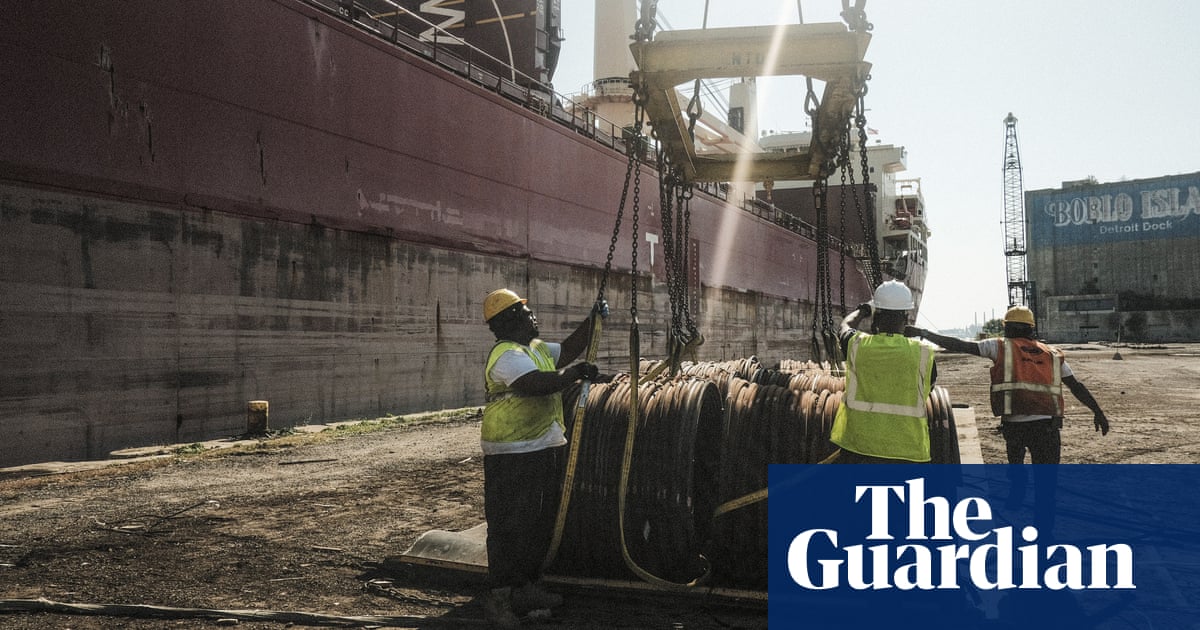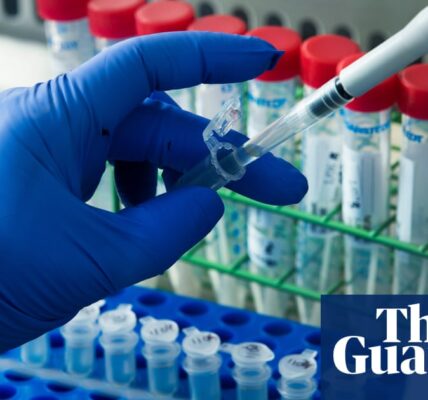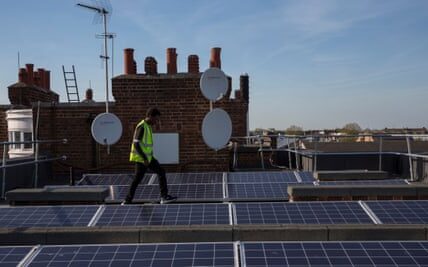‘All these problems are solvable’: Great Lakes shipping fights to cut emissions

It’s just after 9.30pm on a Thursday night in late May when a conveyor belt begins dumping 21,000 tons of road salt into the cavernous hull of the MV Mark M Barker at a dock in Cleveland.
As the first US-flagged freighter to be built on the Great Lakes in nearly 40 years, the 639ft (195-meter)-long ship – launched in 2022 – is the only vessel of its kind in the region powered by cleaner, “tier four” marine engines that meet the federal Environmental Protection Agency rules governing hydrocarbons and particle matter emissions.
“We operate on the Great Lakes exclusively,” says Katie Wells, the manager of environmental stewardship at the Cleveland-based Interlake Maritime Services, which operates more than a dozen large vessels on the Great Lakes, including the MV Mark W Barker. “We never leave here.
“A lot of our crews are from the area, so there’s a vested interest in the future of the lakes.”
Shipping on the Great Lakes and around the world finds itself in the spotlight today as emissions targets set by the International Maritime Organization – the global regulatory agency – mean the industry must find a way to decarbonize by 2050.
That means painful changes lie ahead for the Great Lakes, a region home to more than 34 million residents and some of the largest cities in North America that, for over a century, have served as the industrial backbone of the US. Today, per-capita greenhouse gas emissions in the Great Lakes are 20% above the national average.
To help spur the drive to net zero, US government funding has prompted several Great Lakes ports to start making changes.
The port of Cleveland on Lake Erie is set to spend $32m on upgrades as it pursues a goal of becoming the first zero emissions port on the Great Lakes. Meanwhile, the port of Monroe in Michigan has been awarded $11m in federal funding for its Lake Erie Renewable Energy Resilience Project, an effort that would, in part, see a wharf built exclusively for transporting wind energy cargo.
Last year, the port of Detroit launched a decarbonization project that it hopes would eliminate carbon emissions produced at the port by 2040.
Further west, the port of Milwaukee is already entirely powered by a wind turbine that sends tens of thousands of dollars’ worth of energy back into the electricity grid.
However, while ports have benefited from government help, ship operators and companies say that opportunity has not been extended to them.
“They’ve put billions of dollars into this [port] funding stream, and the vessels that call on these ports are not at all part of that,” Wells, of Interlake Maritime Services, lamented.
“That’s just a miss, unfortunately.”
Shipping is regarded as one of the most efficient ways of transporting bulk goods – 90% of global trade is conducted by ships.
The 21,000 tons of road salt being transported by the MV Mark M Barker, which has been designed to also carry containers, was destined for Green Bay, Wisconsin. Transporting the same cargo by road would take 828 semi-trucks using 560 miles of roads and highways, contributing to emissions and congestion in major metropolises such as Chicago and Milwaukee.
To transport the same volume of salt by train would require 206 rail cars, which are already in short supply.
But finding the right fuel sources and infrastructure is holding back ship owners and operators.
“Evolving technology and energy choices [and] vessel designs that impact how existing ships can be retrofitted to accommodate different fuel options” are among the significant challenges vessel owners face in their decarbonizing efforts, Mark Fisher of the Council of the Great Lakes Region – a non-profit that works with governments and other parties in the US and Canada – recently told the Guardian.
Renewable diesel made from vegetable oils, industry experts say, could serve as a future marine fuel source, but that’s in short supply. Biofuels sourced from feedstock waste could be another.
“There’s a lot of risk associated with trying new technologies,” Wells said. “Any repowering [of vessels] comes with huge costs.”
What’s more, the EPA-required tier four marine engines used by vessels elsewhere are reported to have run into real-world problems.
On land, inadequate refueling infrastructure is seen as another impediment to reaching net zero on the Great Lakes. Many docks that ships load and unload at are privately owned and therefore have few – if any – refueling facilities.
Still, with global shipping emissions targets pegged to be 20% to 30% below 2008 levels as soon as 2030, solutions are expected to coalesce quickly.
And in some ways, shipping on the Great Lakes is already ahead of the game.
Because the lakes are freshwater and not saltwater, ship hulls have been known to remain in operation for close to a century – meaning that, unlike ocean liners, the same vessels can be refitted repeatedly with cleaner, more efficient engines once that technology becomes viable.
At Cop27, held in Egypt in 2022, the Canadian and US governments agreed to form a Green Shipping Corridor Network for the Great Lakes and St Lawrence Seaway to better serve governments, businesses and other operators on the Great Lakes battling to meet emissions targets.
“All of these challenges are solvable,” said Fisher, of the Council of the Great Lakes Region. “But it will require a tremendous amount of collaboration between government, the marine industry, and technology and energy providers.”
Source: theguardian.com



